| |
 |
 |
| |
| India
Coinage: 1997 - 2001 |
|
under President:
Kocheril Raman Narayanan |
| |
| Currency: |
| The Indian rupee (sign: ₹; code: INR) is the
official currency of the Republic of India. The rupee is subdivided into 100
paise (singular paisa), though as of 2018, coins of denomination of 100
paise or one rupee is the lowest value coin in use. The issuance of the
currency is controlled by the Reserve Bank of India. The Reserve Bank
manages currency in India and derives its role in currency management on the
basis of the Reserve Bank of India Act, 1934. The rupee is named after the
silver coin, rupiya, first issued by Sultan Sher Shah Suri in the 16th
century and later continued by the Mughal Empire. |
Mint Marks:
B - Mumbai (Bombay), proof issues only (1969 until 1995)
(B) - Mumbai (Bombay), diamond
C Ottawa (1985 25 Paise; 1988 10, 25 & 50 Paise)
(C) Kolkata (Calcutta) no mint mark
H - Birmingham (1985 Rupee only)
(H) - Hyderabad, star (1963)
(Hd) - Hyderabad, diamond split vertically (1953-1960)
(Hy) - Hyderabad, incuse dot in diamond (1960-1968)
(K) - Kremnica, Slovakia, MK in circle
(L) British Royal Mint, Llantrisant (1985 rupee only), diamond below first
date digit(Ld) British Royal Mint
Llantrisant, tower, looks like a bridge
M - Mumbai (Mumbai [Bombay]), proof only starting 1996
(M) - Mexico City, M beneath O
(N) - Noida, dot
(P) - Pretoria, M in oval
(R) Moscow, MMD in oval
(T) - Taegu (Korea), star below first or last date (1997 and 1998 2 Rupees
only)From 1950 through 1964 the Republic of India proof coins carry the
regular diamond mint mark and can be distinguished from circulation issues
only by their proof-like finish. From 1969 proofs carry the capital B mint
mark. Some Mumbai [Bombay] issues after 1969 have a proof-like appearance although
bearing the diamond mint mark of circulation issues. Beginning in 1972
proofs of the larger denominations - 10, 20 and 100 rupees -were partly
frosted on their main features, including numerals. From 1975 all proofs
were similarly frosted, from the 1 paisa to 100 rupees. Proof-like issues
are often erroneously offered as proofs. |
| |
| |
| 1997 |
| |
| |
|
|
 |
KM#44 20 paise.
Year: 1997.
Weight: 2.24 g
[2.20g].
Metal:
Aluminium.
Diameter: 24.50 mm
x 26.00 mm; Hexagonal (6-sided).
Thickness:
1.70 mm. Edge:
Plain. Alignment:
Medal. Mint:
Hyderabad (Star mintmark below Date). |
|
Obverse:
"पैसे" (paise) written in Devnagari at
the top section. Numerals "20" written in the center with "PAISE"
written below it. Date at the bottom. All details surrounded by
circular design at the border.
Reverse:
Ashoka Pillar Lion Capitol in the center with
"सत्यमेव
जयते" (Satyameva Jayate) [Truth alone triumphs
/ Truth shall prevail] written below
it. "भारत"
(bharat) written on the left side clockwise and "INDIA" written on
the right side clockwise.
Mintage:
N/A. Mintage Years:
1982 (B), 1982 (H), 1982 (H) without
mintmark, 1983 (C), 1983 (H), 1984 (B), 1984 (C), 1984 (H), 1985
(B), 1985 (C), 1985 (H), 1986 (B), 1986 (C), 1986 (H), 1987 (C),
1987 (H), 1988 (B), 1988 (C), 1988 (H), 1989 (C), 1989 (H), 1990
(C), 1990 (H), 1991 (C), 1991 (H), 1992 (H), 1994 (H), 1996 (H) and
1997 (H).
Demonetized: 30
June 2011. |
|
 |
KM#54 25 paise.
Year: 1997.
Weight: 2.82 g
[2.83g].
Metal:
Stainless Steel.
Diameter: 19.00 mm.
Thickness:
1.55 mm. Edge:
Plain. Alignment:
Medal. Mint:
Bombay (Diamond mintmark below Date). |
|
Obverse:
Date with mintmark below it, at the top. Indian Rhinoceros standing
on grass while facing left, in the center.
Reverse: Small Ashoka Pillar Lion Capitol
at the top with
"सत्यमेव
जयते" (Satyameva Jayate) [Truth alone
triumphs] written below it. "भारत"
(bharat) written on the top left side clockwise. "INDIA" written on
the top right side clockwise. "पैसे" (paise)
written at the bottom left side anti-clockwise. "PAISE" written at
the bottom right side anti-clockwise. Large Numerals "25"
written at the bottom section. Mintage:
N/A.
Mintage Years:
1988 (B), 1988 (C), 1988C (Ottawa, Canada),
1988 (H), 1988 (N), 1989 (C) fine grass below rhino, 1989 (C) bold
grass below rhino, 1989 (H), 1989 (N), 1990 (B), 1990 (C), 1990 (H),
1990 (N) Small mintmark, 1991 (B), 1991 (C), 1991 (H), 1991 (N),
1992 (B), 1992 (C), 1992 (H), 1992 (N), 1993 (B), 1993 (C), 1993
(H), 1993 (N), 1994 (B), 1994 (C), 1994 (H), 1994 (N), 1995 (B),
1995 (C), 1995 (H), 1995 (N), 1996 (B), 1996 (C), 1996 (H), 1996
(N), 1997 (B), 1997 (C), 1997 (H), 1997 (N), 1998 (B), 1998 (C),
1998 (H), 1998 (N), 1999 (B), 1999 (C), 1999 (H), 1999 (N), 2000
(B), 2000 (C), 2000 (H), 2000 (N), 2001 (B), 2001 (C), 2001 (H),
2002 (B), 2002 (C) and 2002 (H).
Demonetized:
30th June 2011. |
|
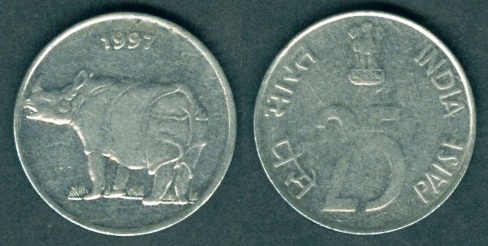 |
Same as above KM#54
25 paise,
but...
Year: 1997.
Weight: 2.89 g
[2.83g].
Mint:
Calcutta (No mintmark below Date). Mintage:
N/A. |
|
 |
Same as above KM#54
25 paise,
but...
Year: 1997.
Weight: 2.84 g
[2.83g].
Mint:
Noida (Dot mintmark below Date).
Mintage:
N/A. |
|
 |
KM#69 50 paise.
Year: 1997.
Weight: 3.86 g
[3.80g].
Metal:
Stainless Steel.
Diameter: 22.00 mm.
Thickness:
1.45 mm. Edge:
Plain. Alignment:
Medal. Mint:
Mumbai [Bombay] (Diamond mintmark below Date). Obverse:
Map of India imposed by circular Parliament house building in New
Delhi in the center. "भारत"
(bharat) written on the top right side clockwise followed by the
word "INDIA" also clockwise. Date with mintmark at the bottom. |
|
Reverse: Small Ashoka Pillar Lion Capitol
at the top with
"सत्यमेव
जयते" (Satyameva Jayate) [Truth alone triumphs]
written below it. Large Numerals "50" written below Ashoka Pillar
Lion Capitol. "भारत"
(bharat) written on the top left side clockwise. "INDIA" written on
the top right side clockwise. "पैसे" (paise)
written at the bottom left side anti-clockwise. "PAISE" written at
the bottom right side anti-clockwise. Mintage:
N/A.
Mintage Years:
1988 (B), 1988 (C), 1988 (Hy), 1988 (N), 1988
(C below date = Ottawa, Canada), 1989 (B), 1989 (C), 1989 (Hy), 1989
(N), 1990 (B), 1990 (C), 1990 (Hy), 1990 (N with small dot), 1990 (N
with large dot), 1991 (B), 1991 (C), 1991 (Hy), 1991 (N), 1992 (B),
1992 (C), 1992 (Hy), 1992 (N), 1993 (C), 1993 (N), 1994 (B), 1994
(C), 1994 (Hy), 1994 (N), 1995 (B), 1995 (C), 1995 (Hy), 1995 (N),
1996 (B), 1996 (C), 1996 (Hy), 1996 (N), 1997 (B), 1997 (C), 1997 (Hy),
1997 (N), 1998 (B), 1998 (C), 1998 (Hy), 1998 (N), 1999 (B), 1999
(C), 1999 (Hy), 1999 (N), 2000 (B), 2000 (C), 2000 (Hy), 2000 (N),
2001 (B), 2001 (C), 2001 (Hy), 2001 (N), 2002 (B), 2002 (C), 2002 (Hy),
2002 (N), 2003 (B), 2003 (C), 2003 (N), 2007 (C) and 2007 (N).
Demonetized:
30th June 2011. |
|
 |
Same as above KM#69 50 paise,
but...
Year: 1997.
Weight: 3.77 g
[3.80g]. Mint:
Noida (Dot mintmark below Date). Mintage:
N/A. |
|
 |
Same as above coin but having slightly Thick date.
Weight: 3.74 g
[3.80g]. |
|
 |
KM#69 50 paise.
Year: 1997.
Weight: 3.78 g
[3.80g].
Metal:
Stainless Steel.
Diameter: 22.00 mm.
Thickness:
1.45 mm. Edge:
Plain. Alignment:
Medal. Mint:
Mumbai [Bombay] (Diamond mintmark below Date). |
|
Obverse:
Gandhi and his followers marching to Dandi in the Salt Satyagraha in
the center. Date with mintmark below the marching people. "स्वतंत्रता
का 50 वाँ वर्ष" (svatantrata ka 50 vaan varsh) [50th year of
independence] written at the bottom left side clockwise. Large ":"
separating Hindi and English legends at the bottom left side. "50TH
YEAR OF INDEPENDENCE" written at the bottom left side clockwise.
Reverse: Small Ashoka Pillar Lion Capitol
at the top with
"सत्यमेव
जयते" (Satyameva Jayate) [Truth alone triumphs]
written below it. Large Numerals "50" written below Ashoka Pillar
Lion Capitol. "भारत"
(bharat) written on the top left side clockwise. "INDIA" written on
the top right side clockwise. "पैसे" (paise)
written at the bottom left side anti-clockwise. "PAISE" written at
the bottom right side anti-clockwise. Mintage:
N/A.
Mintage Years:
1997 (B), 1997 (mintmark "M" for Mumbai
Proof), 1997 (C), 1997 (Hy) and 1997 (N).
Subject: 50th
Year of Independence. Salt Satyagraha (Salt March):
The Salt March, also known as the Salt Satyagraha, Dandi
March and the Dandi Satyagraha, was an act of nonviolent civil
disobedience in colonial India led by Mohandas Karamchand Gandhi.
The 24-day march lasted from 12 March 1930 to 06 April 1930 as a
direct action campaign of tax resistance and nonviolent protest
against the British salt monopoly. The background of this Dandi
March started after Gandhi's early release from prison for political
crimes in 1924, over the second half of the 1920s, Gandhi continued
to pursue swaraj. He pushed through a resolution at the Calcutta
Congress in December 1928 calling on the British government to grant
India dominion status or face a new campaign of non-co-operation
with complete independence for the country as its goal. After his
support for the World War I with Indian combat troops, and the
failure of Khilafat movement in preserving the rule of Caliph in
Turkey, followed by a collapse in Muslim support for his leadership,
some such as Subhas Chandra Bose and Bhagat Singh questioned his
values and non-violent approach. While many Hindu leaders championed
a demand for immediate independence, Gandhi revised his own call to
a one-year wait, instead of two.
The British did not respond favourably to Gandhi's proposal. British
political leaders such as Lord Birkenhead and Winston Churchill
announced opposition to "the appeasers of Gandhi", in their
discussions with European diplomats who sympathised with Indian
demands. On 31 December 1929, the flag of India was unfurled in
Lahore. Gandhi led Congress celebrated 26 January 1930 as India's
Independence Day in Lahore. This day was commemorated by almost
every other Indian organisation. Gandhi then launched a new
Satyagraha against the tax on salt in March 1930. Gandhi sent an
ultimatum in the form of a polite letter to the viceroy of India,
Lord Irwin, on 02 March. Gandhi condemned British rule in the
letter, describing it as "a curse" that "has impoverished the dumb
millions by a system of progressive exploitation and by a ruinously
expensive military and civil administration... It has reduced us
politically to serfdom." Gandhi also mentioned in the letter that
the viceroy received a salary "over five thousand times India's
average income." British violence, Gandhi promised, was going to be
defeated by Indian non-violence.
This was highlighted by the Salt March to Dandi from 12 March to 06
April 1930, where, together with 78 volunteers, he marched 388 kilometres
(241 mi) from Ahmedabad to Dandi, Gujarat to make salt himself, with
the declared intention of breaking the salt laws. The march took 25
days to cover 240 miles with Gandhi speaking to often huge crowds
along the way. Thousands of Indians joined him in Dandi. On 05 May, he
was interned under a regulation dating from 1827 in anticipation of
a protest that he had planned. The protest at Dharasana salt works
on 21 May went ahead without its leader, Gandhi. A horrified
American journalist, Webb Miller, described the British response
thus:
"In complete silence the Gandhi men drew up and halted a hundred
yards from the stockade. A picked column advanced from the crowd,
waded the ditches and approached the barbed wire stockade... at a
word of command, scores of native policemen rushed upon the
advancing marchers and rained blows on their heads with their
steel-shot lathis [long bamboo sticks]. Not one of the marchers even
raised an arm to fend off blows. They went down like ninepins. From
where I stood I heard the sickening whack of the clubs on
unprotected skulls... Those struck down fell sprawling, unconscious
or writhing with fractured skulls or broken shoulders."
This went on for hours until some 300 or more protesters had been
beaten, many seriously injured and two killed. At no time did they
offer any resistance. This campaign was one of his most successful
at upsetting British hold on India; Britain responded by imprisoning
over 60,000 people. Congress estimates, however, put the figure at
90,000. Among them was one of Gandhi's lieutenants, Jawaharlal
Nehru.
According to Sarma, Gandhi recruited women to participate in the
salt tax campaigns and the boycott of foreign products, which gave
many women a new self-confidence and dignity in the mainstream of
Indian public life. However, other scholars such as Marilyn French
state that Gandhi barred women from joining his civil disobedience
movement because he feared he would be accused of using women as
political shield. When women insisted that they join the movement
and public demonstrations, according to Thapar-Bjorkert, Gandhi
asked the volunteers to get permissions of their guardians and only
those women who can arrange child-care should join him. Regardless
of Gandhi's apprehensions and views, Indian women joined the Salt
March by the thousands to defy the British salt taxes and monopoly
on salt mining. After Gandhi's arrest, the women marched and
picketed shops on their own, accepting violence and verbal abuse
from British authorities for the cause in a manner Gandhi inspired. |
|
 |
Same as KM#70 50 paise,
but...
Year: 1997.
Weight: 3.77 g
[3.80g]. Mint:
Noida (Dot mintmark above Dates). Mintage:
N/A. |
|
 |
KM#92.2 Rupee.
Year: 1997.
Weight: 4.88 g
[4.85g].
Metal:
Stainless Steel.
Diameter: 24.50 mm.
Thickness:
1.40 mm. Edge:
Plain. Alignment:
Medal. Mint:
Hyderabad (Star mintmark below Date). Obverse:
"रुपया"
(rupaya) written at the top. Numeral "1" in the center with grain ears
flank on each side. "RUPEE" written below numeral "1". Date written
at the bottom. Type2: Plain / Smooth edge. |
|
Reverse: Ashoka Pillar Lion Capitol in the center with
"सत्यमेव
जयते" (Satyameva Jayate) [Truth alone triumphs]
written below it. "भारत"
(bharat) written on the left side clockwise and "INDIA" written on
the right side clockwise. Mintage:
N.A.
Mintage Years:
1995 (B), 1995 (Hy), 1995 (N), 1996 (B), 1996
(C), 1996 (Hy), 1996 (N), 1997 (B), 1997 (C), 1997 (Hy), 1997 (M),
1997 (N), 1998 (B), 1998 (C), 1998 (Hy), 1998 (K), 1998 (N), 1998
(P), 1999 (B), 1999 (C), 1999 (Hy), 1999 (K), 1999 (N), 1999 (P), 2000 (B),
2000 (C), 2000 (Hy), 2000 (K), 2000 (N), 2000 (P), 2001 (B), 2001 (C),
2001 (Hy) Small and large mint mark exist with doubled left or right
of wheat stalks, 2001 (K), 2001
(N), 2002 (B), 2002 (C), 2002 (Hy), 2002 (N), 2003
(B), 2003 (C), 2003 (Hy), 2003 (N), 2004 (B), 2004 (C), 2004 (Hy) and 2004 (N). |
|
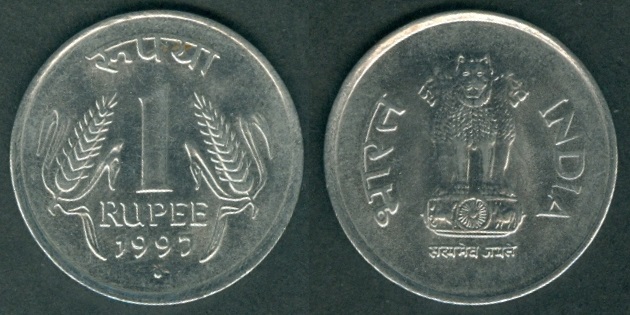 |
Same as above KM#92.2 Rupee,
but...
Year: 1997.
Weight: 4.85 g
[4.85g]. Mint:
Noida (Dot mintmark below Date). Mintage:
N.A. |
|
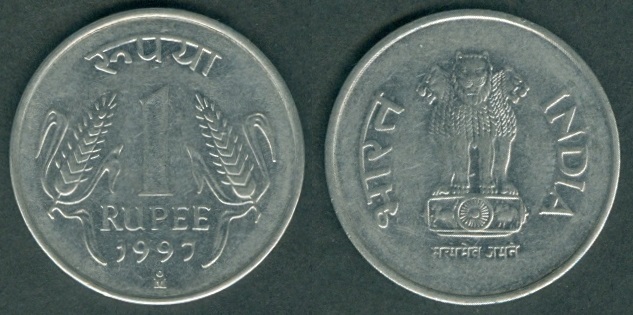 |
Same as above KM#92.2 Rupee,
but...
Year: 1997.
Weight: 4.97 g
[4.85g]. Mint:
Mexico City (Circle above M mintmark below Date).
Mintage:
N.A. |
|
 |
KM#98 Rupee.
Year: 1997.
Weight: 4.85 g
[4.85g].
Metal: Stainless
Steel.
Diameter: 24.50 mm.
Thickness:
1.40 mm. Edge:
Plain. Alignment:
Medal. Mint:
Mumbai [Bombay] (Diamond mintmark below the Date). |
|
Obverse: Cellular
Jail Building at Port Blair in the center. "सेल्युलर जेल"
(cellular jail) written in Hindi on the left side clockwise.
"CELLULAR JAIL" written on the right side clockwise. "पोर्ट
ब्लेयर" (port blair) written in Hindi at the bottom left side
and "PORT BLAIR" written at the bottom right side. Date and mintmark
at the bottom.
Reverse:
Ashoka Pillar Lion Capitol in the center
position with
"सत्यमेव
जयते" (Satyameva Jayate) [Truth alone triumphs]
written below it. "भारत"
(bharat) written on the top left side clockwise and "INDIA" written
on the top right side clockwise. "रुपया"
(rupaya) written at the bottom left side anti-clockwise and "RUPEE"
written at the bottom right side anti-clockwise. Numeral "1" written
at the bottom. Mintage:
N/A.
Mintage Years:
1997B, 1997C, 1997Hy and 1997N.
Subject: Cellular
Jail Building at Port Blair. Port Blair is the
capital city of the Andaman and Nicobar Islands, a union territory
of India in the Bay of Bengal. It is also the local administrative
sub-division (tehsil) of the islands, the headquarters for the
district of South Andaman, and is the territory's only notified
town.
Port Blair serves as the entry point for visiting the Andaman and
Nicobar Islands. Port Blair is connected with mainland India by both
air and sea. It is a 2-3 hour flight from mainland India to Port
Blair's Veer Savarkar International Airport, and 34 days by sea to
reach Kolkata, Chennai or Visakhapatnam from Haddo Wharf in Port
Blair. It is home to several museums and a major naval base INS
Jarawa of the Indian Navy, along with sea and air bases of the
Indian Coast Guard, Andaman and Nicobar Police, Andaman and Nicobar
Command, the first integrated tri-command of the Indian Armed Forces
and the Indian Air Force. Port Blair is also famous for the historic
Cellular Jail and other small islands like Corbyn's Cove, Wandoor,
Ross Island, Viper Island etc. which were once home to British
colonists. Port Blair has been selected as one of the cities to be
developed as a smart city under the Smart Cities Mission.
The Empire of Japan invaded the Andaman islands in March 1942
capturing the small British garrison. The Cellular Jail then became
home to British, suspected British India supporters, and later of
members of the Indian Independence League, many of whom were
tortured and killed there. Notionally during this period control of
the Islands was passed to Subhas Chandra Bose, who hoisted the
Indian National Flag for the first time on the islands, at the
Gymkhana Ground in Port Blair, appointed INA General AD Loganathan
as the governor of the Islands, and announced the Azad Hind
Government was not merely a Government in Exile, and had freed the
territory from the British rule. On 07 October 1945 the British
resumed control of the Islands, and prison, following the surrender
of the islands to Brigadier J. A. Salomons, of the 116th Indian
Infantry Brigade, a month after the Surrender of Japan, at the end
of World War II.
The Cellular Jail, also known as Kala Pani (Hindi for black
waters), was a colonial prison in the Andaman and Nicobar Islands,
India. The prison was used by the British for the express purpose of
exiling political prisoners to the remote archipelago. Many notable
independence activists, including Batukeshwar Dutt, Yogendra Shukla
and Vinayak Damodar Savarkar, were imprisoned here during the
struggle for India's independence. Today, the complex serves as a
national memorial monument. The prison complex itself was
constructed between 1896 and 1906, the British had been using the
Andaman Islands as a prison since the days in the immediate
aftermath of the revolt of 1857. The original building was a puce-coloured
brick building. The building had seven wings, at the centre of which
a tower served as the intersection and was used by guards to keep
watch on the inmates; this format was based on Jeremy Bentham's idea
of the Panopticon. The wings radiated from the tower in straight
lines, much like the spokes of a bicycle wheel. Each of the seven
wings had three stories upon completion. There were no dormitories
and a total of 696 cells. Each cell was 4.5 by 2.7 metres (14.8 ft ×
8.9 ft) in size with a ventilator located at a height of 3 metres
(9.8 ft). The name, "cellular jail", derived from the solitary cells
which prevented any prisoner from communicating with any other.
Also, the spokes were so designed such that the face of a cell in a
spoke saw the back of cells in another spoke. This way,
communication between prisoners was impossible. They were all in
solitary confinement.
Another two wings of the jail were demolished after India achieved
independence. However, this led to protests from several former
prisoners and political leaders who saw it as a way of erasing the
tangible evidence of their history.
The Govind Ballabh Pant Hospital was set up in the premises of the
Cellular Jail in 1963. It is now a 500-bed hospital with about 40
doctors serving the local population.
The centenary of the jail's completion was marked on 10 March 2006.
Many former prisoners were celebrated on this occasion by the
Government of India. |
|
 |
KM#121.5 Rupee.
Year: 1997.
Weight: 6.01 g
[6.00g].
Metal:
Copper-Nickel.
Diameter: 26.00 mm;
11 sided (Hendecagonal).
Thickness:
1.71 mm. Edge:
Plain. Alignment:
Medal. Mint:
Taegu, Korea (Star below the last digit in Date).
Mintage:
N/A.
TypeC:
Asoka Column 13mm tall, 4 fur rows on right lion.
Further coin details under
1995. |
|
 |
Same as KM#154.1 Five Rupee,
but...
Year: 1997.
Weight: 8.75 g
[9.00g]. Mint:
Mumbai [Bombay] (Diamond mintmark below Date). Mintage:
N/A.
Type1: Security edge.
Further coin details under
1992. |
|
 |
Same as KM#154.1 Five Rupee,
but...
Year: 1997.
Weight: 8.92 g
[9.00g]. Mint:
Hyderabad (Star mintmark below Date). Mintage:
N/A.
Type1: Security edge.
Further coin details under
1992. |
|
 |
Same as KM#154.1 Five Rupee,
but...
Year: 1997.
Weight: 8.98 g
[9.00g]. Mint:
Noida (Dot mintmark below Date). Mintage:
N/A.
Type1: Security edge.
Further coin details under
1992. |
| |
|
| |
|
|
| |
| 1998 |
| |
| |
|
|
 |
Same as above KM#54
25 paise,
but...
Year: 1998.
Weight: 2.82 g
[2.83g].
Mint:
Bombay (Diamond mintmark below Date). Mintage:
N/A. |
|
 |
Same as above KM#54
25 paise,
but...
Year: 1998.
Weight: 2.83 g
[2.83g].
Mint:
Calcutta (No mintmark below Date). Mintage:
N/A. |
|
 |
Same as above KM#54
25 paise,
but...
Year: 1998.
Weight: 2.87 g
[2.83g].
Mint:
Hyderabad (Star mintmark below Date). Mintage:
N/A. |
|
 |
Same as above KM#54
25 paise,
but...
Year: 1998.
Weight: 2.81 g
[2.83g].
Mint:
Noida (Dot mintmark below Date).
Mintage:
N/A. |
|
 |
Same as above KM#69 50 paise,
but...
Year: 1998.
Weight: 3.73 g
[3.80g]. Mint:
Mumbai [Bombay] (Diamond mintmark below Date).
Mintage:
N/A. |
|
 |
Same as above KM#69 50 paise,
but...
Year: 1998.
Weight: 3.82 g
[3.80g]. Mint:
Hyderabad (Star mintmark below Date). Mintage:
N/A. |
|
 |
Same as above KM#69 50 paise,
but...
Year: 1998.
Weight: 3.79 g
[3.80g]. Mint:
Noida (Dot mintmark below Date). Mintage:
N/A. |
|
 |
Same as above KM#92.2 Rupee,
but...
Year: 1998.
Weight: 4.84 g
[4.85g]. Mint:
Mumbai [Bombay] (Diamond mintmark below Date). Mintage:
N.A. |
|
 |
Same as above KM#92.2 Rupee,
but...
Year: 1998.
Weight: 4.93 g
[4.85g]. Mint:
Hyderabad (Star mintmark below Date). Mintage:
N.A. |
|
 |
Same as above KM#92.2 Rupee,
but...
Year: 1998.
Weight: 4.91 g
[4.85g]. Mint:
Kremnica (mk written in oval mintmark below Date).
Mintage:
N.A. |
|
 |
Same as above coin, but slightly rotated as shown.
Weight: 4.96 g
[4.85g]. |
|
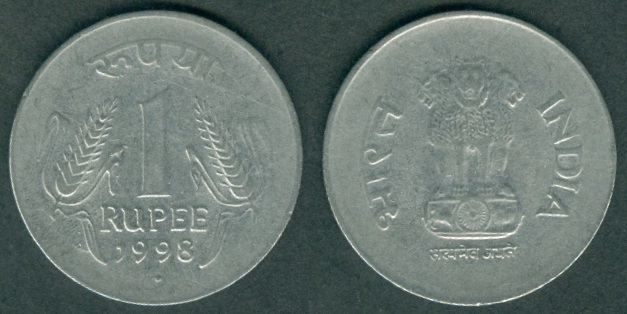 |
Same as above KM#92.2 Rupee,
but...
Year: 1998.
Weight: 4.94 g
[4.85g]. Mint:
Noida (Dot mintmark below Date). Mintage:
N.A. |
|
 |
Same as above KM#121.5 Two Rupee,
but...
Year: 1998.
Weight: 5.81 g
[6.00g]. Mint:
Mumbai [Bombay] (Diamond mintmark below Date). Mintage:
N/A.
TypeC:
Asoka Column 13mm tall, 4 fur rows on right lion.
Further coin details under
1995. |
|
 |
Same as above KM#121.5 Two Rupee,
but...
Year: 1998.
Weight: 6.15 g
[6.00g]. Mint:
Hyderabad (Star mintmark below Date). Mintage:
N/A.
TypeC:
Asoka Column 13mm tall, 4 fur rows on right lion.
Further coin details under
1995. |
|
 |
Same as above KM#121.5 Two Rupee,
but...
Year: 1998.
Weight: 6.07 g
[6.00g]. Mint:
Pretoria, South Africa (M in oval mintmark below Date). Mintage:
N/A.
TypeC:
Asoka Column 13mm tall, 4 fur rows on right lion.
Further coin details under
1995. |
|
 |
Same as above KM#121.5 Two Rupee,
but...
Year: 1998.
Weight: 6.03 g
[6.00g]. Mint:
Taegu, Korea (Star below the last digit in Date).
Mintage:
N/A.
TypeC:
Asoka Column 13mm tall, 4 fur rows on right lion.
Further coin details under
1995. |
|
 |
Same as KM#154.2 Five Rupee,
but...
Year: 1998.
Weight: 8.68 g
[9.00g]. Mint:
Mumbai [Bombay] (Diamond mintmark below Date). Mintage:
N/A.
Type2: Reeded edge.
This coin has security line but also some position of Reeded edge. |
|
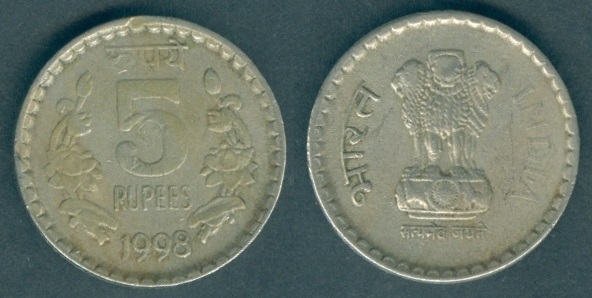 |
Same as KM#154.1 Five Rupee,
but...
Year: 1998.
Weight: 8.77 g
[9.00g]. Mint:
Calcutta (No mintmark below Date). Mintage:
N/A.
Type1: Security edge.
Further coin details under
1992. |
|
 |
Same as KM#154.1 Five Rupee,
but...
Year: 1998.
Weight: 9.03 g
[9.00g]. Mint:
Hyderabad (Star mintmark below Date). Mintage:
N/A.
Type1: Security edge.
Further coin details under
1992. |
|
 |
Same as KM#154.1 Five Rupee,
but...
Year: 1998.
Weight: 8.93 g
[9.00g]. Mint:
Noida (Dot mintmark below Date). Mintage:
N/A.
Type1: Security edge.
Further coin details under
1992. |
| |
|
| |
|
|
| |
| 1999 |
| |
| |
|
|
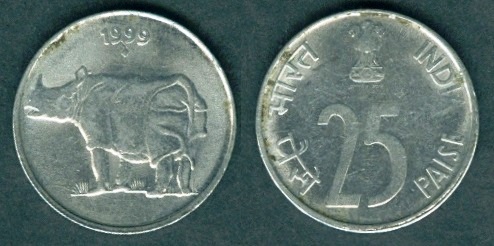 |
Same as above KM#54
25 paise,
but...
Year: 1999.
Weight: 2.86 g
[2.83g].
Mint:
Bombay (Diamond mintmark below Date). Mintage:
N/A. |
|
 |
Same as above KM#54
25 paise,
but...
Year: 1999.
Weight: 2.92 g
[2.83g].
Mint:
Calcutta (No mintmark below Date). Mintage:
N/A. |
|
 |
Same as above KM#54
25 paise,
but...
Year: 1999.
Weight: 2.87 g
[2.83g].
Mint:
Hyderabad (Star mintmark below Date). Mintage:
N/A. |
|
 |
Same as above KM#54
25 paise,
but...
Year: 1999.
Weight: 2.85 g
[2.83g].
Mint:
Noida (Dot mintmark below Date).
Mintage:
N/A. |
|
 |
Same as above KM#69 50 paise,
but...
Year: 1999.
Weight: 3.91 g
[3.80g]. Mint:
Mumbai [Bombay] (Diamond mintmark below Date). Mintage:
N/A. |
|
 |
Same as above KM#69 50 paise,
but...
Year: 1999.
Weight: 3.88 g
[3.80g]. Mint:
Calcutta (No mintmark below Date). Mintage:
N/A. |
|
 |
Same as above KM#69 50 paise,
but...
Year: 1999.
Weight: 3.84 g
[3.80g]. Mint:
Hyderabad (Star mintmark below Date). Mintage:
N/A. |
|
 |
Same as above coin but having slightly Thick date.
Weight: 3.83 g
[3.80g]. |
|
 |
Same as above KM#69 50 paise,
but...
Year: 1999.
Weight: 3.80 g
[3.80g]. Mint:
Noida (Dot mintmark below Date). Mintage:
N/A. |
|
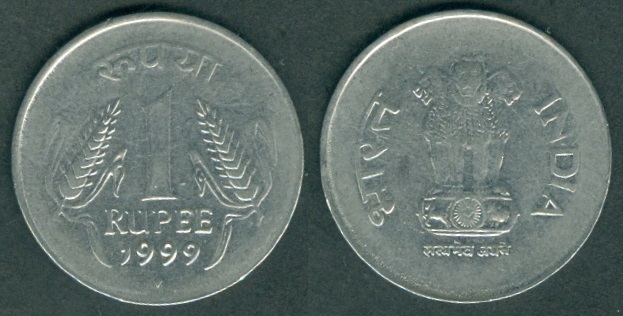 |
Same as above KM#92.2 Rupee,
but...
Year: 1999.
Weight: 4.93 g
[4.85g]. Mint:
Mumbai [Bombay] (Diamond mintmark below Date). Mintage:
N.A. |
|
 |
Same as above KM#92.2 Rupee,
but...
Year: 1999.
Weight: 4.85 g
[4.85g]. Mint:
Calcutta (No mintmark below Date). Mintage:
N.A. |
|
 |
 |
| This coin has double lettering on the Reverse side
as shown above. |
|
Same as above KM#92.2 Rupee,
but...
Year: 1999.
Weight: 4.98 g
[4.85g]. Mint:
Hyderabad (Star mintmark below Date). Mintage:
N.A. |
|
 |
Same as above coin, but slightly rotated on Obverse
side as shown.
Weight: 4.88 g
[4.85g]. |
|
 |
Same as above KM#92.2 Rupee,
but...
Year: 1999.
Weight: 4.88 g
[4.85g]. Mint:
Kremnica (mk written in oval mintmark below Date).
Mintage:
N.A. |
|
 |
Same as above KM#92.2 Rupee,
but...
Year: 1999.
Weight: 4.94 g
[4.85g]. Mint:
Noida (Dot mintmark below Date). Mintage:
N.A. |
|
 |
KM#295.2 Rupee.
Year: 1999.
Weight: 4.87 g
[4.85g].
Metal: Stainless
Steel.
Diameter: 24.50 mm.
Thickness:
1.40 mm. Edge:
Plain. Alignment:
Medal. Mint:
Mumbai [Bombay] (Diamond mintmark below the Date).
Type2:
Asoka column 13.8 mm tall. |
|
Obverse:
Saint sitting cross legged on pedestal, facing
3/4 left in the center. "संत ज्ञानेश्वर"
(Saint Dnyaneshwar) written in Hindi on the left side clockwise.
"SAINT DNYANESHWAR 1274-1296 A.D." written from 9 o'clock
towards the right side clockwise. Dot at the left side between Hindi
and English legends. Date "· 1999 ·" and mintmark at the bottom.
Reverse:
Ashoka Pillar Lion Capitol in the center
position with
"सत्यमेव
जयते" (Satyameva Jayate) [Truth alone triumphs]
written below it. "भारत"
(bharat) written on the top left side clockwise and "INDIA" written
on the top right side clockwise. "रुपया"
(rupaya) written at the bottom left side anti-clockwise and "RUPEE"
written at the bottom right side anti-clockwise. Numeral "1" written
at the bottom. Mintage:
N/A.
Subject: Saint
Dnyaneshwar.
Type of Saint
Dnyaneshwar Dated 1999 coins by various
mints:
- KM#295.1 (Calcutta Mint; Asoka column 13.2 mm tall).
- KM#295.1 (Mumbai Mint; Asoka column 13.2 mm tall).
- KM#295.2 (Mumbai Mint; Asoka column 13.8 mm tall).
- KM#295.3 (Noida Mint; Asoka column 14.5 mm tall).
Sant Dnyaneshwar, also referred to as Jnaneshwar,
Jnanadeva, Dnyandev or Mauli (12751296). He was born in Apegaon,
Sevuna Samrajyam (present-day: Paithan Taluka, Aurangabad,
Maharashtra, India) as Dnyaneshwar Vitthalpant Kulkarni. He was the
son of Vitthala Pant (father) and Rukmini Bai (mother). He was a
13th-century Indian Marathi saint, poet, philosopher and yogi of the
Nath Vaishnava tradition. In his short life of 21 years, he authored
Dnyaneshwari (a commentary on the Bhagavad Gita) and Amrutanubhav.
These are the oldest surviving literary works in the Marathi
language, under the patronage of the Yadava dynasty of Devagiri, and
these are considered to be milestones in Marathi literature.
Dnyaneshwar's ideas reflect the non-dualistic Advaita Vedanta
philosophy and an emphasis on Yoga and oneness of Vishnu and Shiva,
but an ardent devotee of Lord Vitthala (a form of Lord Vishnu) of
Pandharpur. His legacy inspired saint-poets such as Eknath and
Tukaram, and he has been regarded as one of the founders of the
Varkari (Vithoba-Krishna) Bhakti movement tradition of Hinduism in
Maharashtra. He died at Alandi, Yadava kingdom (present-day: Pune
District, Maharashtra, India). |
|
 |
Same as above KM#121.5 Two Rupee,
but...
Year: 1999.
Weight: 5.93 g
[6.00g]. Mint:
Mumbai [Bombay] (Diamond mintmark below Date). Mintage:
N/A.
TypeC:
Asoka Column 13mm tall, 4 fur rows on right lion.
Further coin details under
1995. |
|
 |
Same as above KM#121.5 Two Rupee,
but...
Year: 1999.
Weight: 6.14 g
[6.00g]. Mint:
Hyderabad (Star mintmark below Date). Mintage:
N/A.
TypeC:
Asoka Column 13mm tall, 4 fur rows on right lion.
Further coin details under
1995. |
|
 |
Same as above KM#121.5 Two Rupee,
but...
Year: 1999.
Weight: 6.01 g
[6.00g]. Mint:
Llantrisant, UK (Tray mintmark below Date).
Mintage:
N/A.
TypeC:
Asoka Column 13mm tall, 4 fur rows on right lion.
Further coin details under
1995. |
|
 |
Same as above KM#121.5 Two Rupee,
but...
Year: 1999.
Weight: 5.96 g
[6.00g]. Mint:
Noida (Dot mintmark below Date). Mintage:
N/A.
TypeC:
Asoka Column 13mm tall, 4 fur rows on right lion.
Further coin details under
1995. |
|
 |
KM#154.4 5 Rupees.
Year: 1999.
Weight: 8.95 g
[9.00g].
Metal:
Copper-Nickel.
Diameter: 22.50 mm.
Thickness:
3.00 mm. Edge:
Security. Alignment:
Medal. Mint:
Mumbai [Bombay] (Diamond mintmark below Date). Mintage:
N/A.
Type4: Security edge but Asoka base
thinner and smaller (Type C Asoka Column). |
|
Obverse:
"रुपया"
(rupaya) written at the top. Numeral "5" in the center with
Lotus flower stem on each side. "RUPEES" written below numeral "5". Date written
at the bottom. Reverse:
Ashoka Pillar Lion Capitol in the center with
"सत्यमेव
जयते" (Satyameva Jayate) [Truth alone triumphs]
written below it. "भारत"
(bharat) written on the left side clockwise and "INDIA" written on
the right side clockwise. Mintage
Years: 1998 (B), 1999 (B), 2000 (B),
2001 (B), 2002 (B), 2003 (B) and 2004 (B). |
|
 |
Same as KM#154.1 Five Rupee,
but...
Year: 1999.
Weight: 9.02 g
[9.00g]. Mint:
Hyderabad (Star mintmark below Date). Mintage:
N/A.
Type1: Security edge.
Further coin details under
1992. |
|
 |
Same as KM#154.1 Five Rupee,
but...
Year: 1999.
Weight: 8.96 g
[9.00g]. Mint:
Noida (Dot mintmark below Date). Mintage:
N/A.
Type1: Security edge.
Further coin details under
1992. |
|
 |
Same as KM#154.1 Five Rupee,
but...
Year: 1999.
Weight: 9.05 g
[9.00g]. Mint:
Moscow (MMD in oval mintmark below Date). Mintage:
N/A.
Type1: Security edge.
Further coin details under
1992. |
| |
|
| |
|
| |
|
|
| |
| 2000 |
| |
| |
|
|
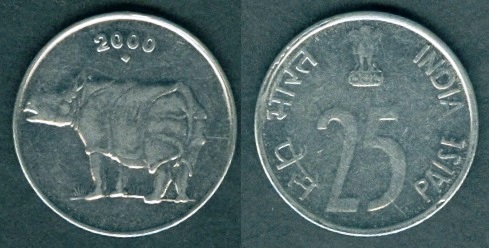 |
Same as above KM#54
25 paise,
but...
Year: 2000.
Weight: 2.84 g
[2.83g].
Mint:
Bombay (Diamond mintmark below Date). Mintage:
N/A. |
|
 |
Same as above KM#54
25 paise,
but...
Year: 2000.
Weight: 2.85 g
[2.83g].
Mint:
Calcutta (No mintmark below Date). Mintage:
N/A. |
|
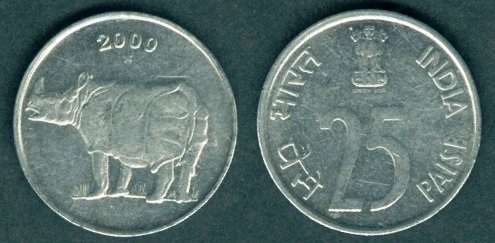 |
Same as above KM#54
25 paise,
but...
Year: 2000.
Weight: 2.79 g
[2.83g].
Mint:
Hyderabad (Star mintmark below Date). Mintage:
N/A. |
|
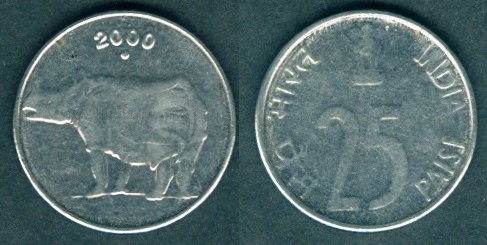 |
Same as above KM#54
25 paise,
but...
Year: 2000.
Weight: 2.88 g
[2.83g].
Mint:
Noida (Dot mintmark below Date).
Mintage:
N/A. |
|
 |
Same as above KM#69 50 paise,
but...
Year: 2000.
Weight: 3.84 g
[3.80g]. Mint:
Mumbai [Bombay] (Diamond mintmark below Date). Mintage:
N/A. |
|
 |
Same as above KM#69 50 paise,
but...
Year: 2000.
Weight: 3.83 g
[3.80g]. Mint:
Calcutta (No mintmark below Date). Mintage:
N/A. |
|
 |
Same as above KM#69 50 paise,
but...
Year: 2000.
Weight: 3.85 g
[3.80g]. Mint:
Hyderabad (Star mintmark below Date). Mintage:
N/A. |
|
 |
Same as above coin but having slightly Thick date.
Weight: 3.80 g
[3.80g]. |
|
 |
Same as above KM#69 50 paise,
but...
Year: 2000.
Weight: 3.82 g
[3.80g]. Mint:
Noida (Dot mintmark below Date). Mintage:
N/A. |
|
 |
Same as above KM#92.2 Rupee,
but...
Year: 2000.
Weight: 4.89 g
[4.85g]. Mint:
Calcutta (No mintmark below Date). Mintage:
N.A. |
|
 |
Same as above coin, but slightly rotated as shown.
Weight: 4.92 g
[4.85g]. |
|
 |
Same as above KM#92.2 Rupee,
but...
Year: 2000.
Weight: 4.95 g
[4.85g]. Mint:
Hyderabad (Star mintmark below Date). Mintage:
N.A. |
|
 |
Same as above coin, but slightly rotated as shown.
Weight: 5.03 g
[4.85g]. |
|
 |
Same as above KM#92.2 Rupee,
but...
Year: 2000.
Weight: 4.79 g
[4.85g]. Mint:
Kremnica (mk written in oval mintmark below Date).
Mintage:
N.A. |
|
 |
Same as above KM#92.2 Rupee,
but...
Year: 2000.
Weight: 4.96 g
[4.85g]. Mint:
Noida (Dot mintmark below Date). Mintage:
N.A. |
|
 |
KM#121.3 Rupee.
Year: 2000.
Weight: 5.86 g
[6.00g].
Metal:
Copper-Nickel.
Diameter: 26.00 mm;
11 sided (Hendecagonal).
Thickness:
1.71 mm. Edge:
Plain. Alignment:
Medal. Mint:
Calcutta (No mintmark below Date). Mintage:
N/A.
TypeA:
Asoka Column 15mm tall, 5 fur rows on right lion, no lion whiskers.
Further coin details under
1992. |
|
 |
KM#121.4 Rupee.
Year: 2000.
Weight: 5.99 g
[6.00g].
Metal:
Copper-Nickel.
Diameter: 26.00 mm;
11 sided (Hendecagonal).
Thickness:
1.71 mm. Edge:
Plain. Alignment:
Medal. Mint:
Noida (Dot mintmark below Date). Mintage:
N/A.
Unlisted mint under TypeB.
TypeB:
Asoka Column 14mm tall, 3 fur rows on right lion, 5 lion whiskers.
Further coin details under
1992. |
|
 |
Same as above KM#121.5 Two Rupee,
but...
Year: 2000.
Weight: 6.05 g
[6.00g]. Mint:
Mumbai [Bombay] (Diamond mintmark below Date). Mintage:
N/A.
TypeC:
Asoka Column 13mm tall, 4 fur rows on right lion.
Further coin details under
1995. |
|
 |
Same as above KM#121.5 Two Rupee,
but...
Year: 2000.
Weight: 6.21 g
[6.00g]. Mint:
Hyderabad (Star mintmark below Date). Mintage:
N/A.
TypeC:
Asoka Column 13mm tall, 4 fur rows on right lion.
Further coin details under
1995. |
|
 |
Same as above KM#121.5 Two Rupee,
but...
Year: 2000.
Weight: 6.05 g
[6.00g]. Mint:
Moscow, Russia (MMD in oval mintmark below Date).
Mintage:
N/A.
TypeC:
Asoka Column 13mm tall, 4 fur rows on right lion.
Further coin details under
1995. |
|
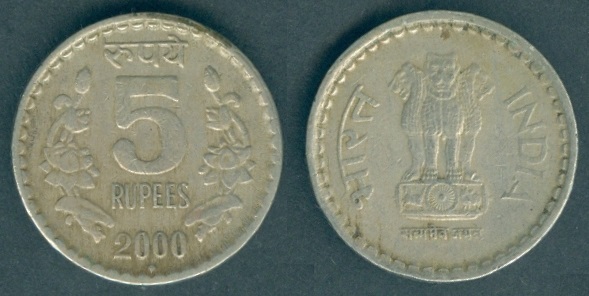 |
Same as KM#154.4 Five Rupee,
but...
Year: 2000.
Weight: 9.13 g
[9.00g]. Mint:
Mumbai [Bombay] (Diamond mintmark below Date). Mintage:
N/A.
Type4: Security edge but Asoka base
thinner and smaller (Type C Asoka Column).
For further coin details, see above under 1999. |
|
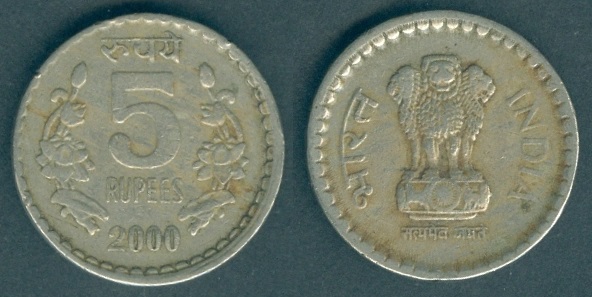 |
Same as KM#154.1 Five Rupee,
but...
Year: 2000.
Weight: 8.70 g
[9.00g]. Mint:
Calcutta (No mintmark below Date). Mintage:
N/A. This coin has Large Dots within
center security line.
Type1: Security edge.
Further coin details under
1992. |
|
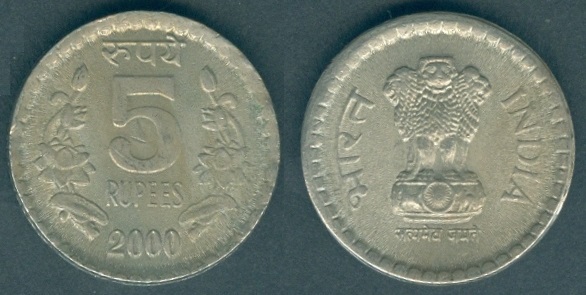 |
Same as above coin with Large Dots within
center security line, but also has some position of Reeded edge.
Weight: 8.78 g |
|
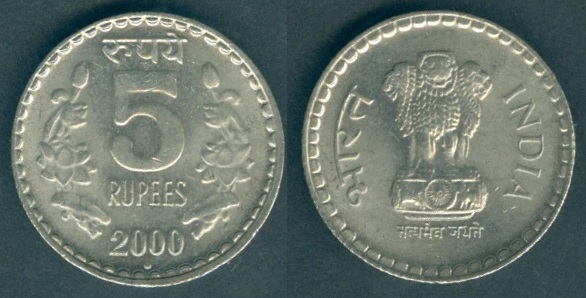 |
Same as KM#154.1 Five Rupee,
but...
Year: 2000.
Weight: 9.04 g
[9.00g]. Mint:
Noida (Dot mintmark below Date). Mintage:
N/A.
Type1: Security edge.
Further coin details under
1992. |
|
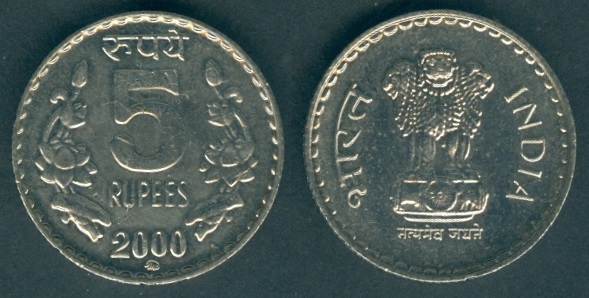 |
Same as KM#154.1 Five Rupee,
but...
Year: 2000.
Weight: 9.01 g
[9.00g]. Mint:
Moscow (MMD in oval mintmark below Date). Mintage:
N/A.
Type1: Security edge.
Further coin details under
1992. |
| |
|
|
| |
| 2001 |
| |
| |
|
|
 |
Same as above KM#54
25 paise,
but...
Year: 2001.
Weight: 2.81 g
[2.83g].
Mint:
Bombay (Diamond mintmark below Date). Mintage:
N/A. |
|
 |
Same as above KM#54
25 paise,
but...
Year: 2001.
Weight: 2.79 g
[2.83g].
Mint:
Calcutta (No mintmark below Date). Mintage:
N/A. |
|
 |
Same as above KM#54
25 paise,
but...
Year: 2001.
Weight: 2.82 g
[2.83g].
Mint:
Hyderabad (Star mintmark below Date). Mintage:
N/A. |
|
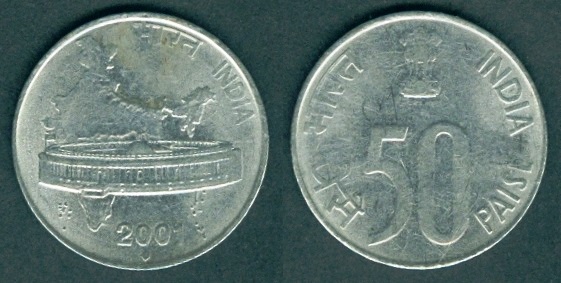 |
Same as above KM#69 50 paise,
but...
Year: 2001.
Weight: 3.85 g
[3.80g]. Mint:
Mumbai [Bombay] (Diamond mintmark below Date). Mintage:
N/A. |
|
 |
Same as above coin but having Thick date.
Weight: 3.90 g
[3.80g]. |
|
 |
Same as above KM#69 50 paise,
but...
Year: 2001.
Weight: 3.91 g
[3.80g]. Mint:
Calcutta (No mintmark below Date). Mintage:
N/A. |
|
 |
Same as above KM#69 50 paise,
but...
Year: 2001.
Weight: 3.81 g
[3.80g]. Mint:
Hyderabad (Star mintmark below Date). Mintage:
N/A. |
|
 |
Same as above coin but having Thick Date.
Weight: 3.85 g
[3.80g]. |
|
 |
Same as above KM#92.2 Rupee,
but...
Year: 2001.
Weight: 5.04 g
[4.85g]. Mint:
Mumbai [Bombay] (Diamond mintmark below Date). Mintage:
N.A. |
|
 |
Same as above coin but, slightly off flan on Obverse
side.
Weight: 4.93 g. |
|
 |
Same as above KM#92.2 Rupee,
but...
Year: 2001.
Weight: 5.04 g
[4.85g]. Mint:
Calcutta (No mintmark below Date). Mintage:
N.A. |
|
 |
Same as above KM#92.2 Rupee,
but...
Year: 2001.
Weight: 4.85 g
[4.85g]. Mint:
Hyderabad (Star mintmark below Date). Mintage:
N.A. |
|
 |
Same as above coin but having thick star as
mintmark.
Weight: 4.90 g
[4.85g]. |
|
 |
Same as above KM#92.2 Rupee,
but...
Year: 2001.
Weight: 4.80 g
[4.85g]. Mint:
Kremnica (mk written in oval mintmark below Date).
Mintage:
N.A. |
|
 |
Same as above KM#92.2 Rupee,
but...
Year: 2001.
Weight: 4.83 g
[4.85g]. Mint:
Noida (Dot mintmark below Date). Mintage:
N.A. |
|
 |
Same as above KM#121.5 Two Rupee,
but...
Year: 2001.
Weight: 5.98 g
[6.00g]. Mint:
Mumbai [Bombay] (Diamond mintmark below Date). Mintage:
N/A.
TypeC:
Asoka Column 13mm tall, 4 fur rows on right lion.
Further coin details under
1995. |
|
 |
Same as above KM#121.5 Two Rupee,
but...
Year: 2001.
Weight: 6.18 g
[6.00g]. Mint:
Hyderabad (Star mintmark below Date). Mintage:
N/A.
TypeC:
Asoka Column 13mm tall, 4 fur rows on right lion.
Further coin details under
1995. |
|
 |
Same as above KM#121.5 Two Rupee,
but...
Year: 2001.
Weight: 6.06 g
[6.00g]. Mint:
Noida (Dot mintmark below Date). Mintage:
N/A.
TypeC:
Asoka Column 13mm tall, 4 fur rows on right lion.
Further coin details under
1995. |
|
 |
Same as KM#154.4 Five Rupee,
but...
Year: 2001.
Weight: 8.71 g
[9.00g]. Mint:
Mumbai [Bombay] (Diamond mintmark below Date). Mintage:
N/A.
Type4: Security edge but Asoka base
thinner and smaller (Type C Asoka Column).
For further coin details, see above under 1999. |
|
 |
Same as KM#154.1 Five Rupee,
but...
Year: 2001.
Weight: 9.00 g
[9.00g]. Mint:
Hyderabad (Star mintmark below Date). Mintage:
N/A.
Type1: Security edge.
Further coin details under
1992. |
|
 |
Same as above coin, but having Large Dots within
center security line. The Obverse side is also slightly off flan as
shown.
Weight: 8.81 g |
|
 |
Same as KM#154.1 Five Rupee,
but...
Year: 2000.
Weight: 9.04 g
[9.00g]. Mint:
Noida (Dot mintmark below Date). Mintage:
N/A.
Type1: Security edge.
Further coin details under
1992. |
|
 |
Same as above coin, but the first zero is Date is
semi filled.
Weight: 8.95 g. |
|
 |
KM#304 5 Rupees.
Year: 2001.
Weight: 8.80 g
[9.00g].
Metal:
Copper-Nickel.
Diameter: 22.50 mm.
Thickness:
3.00 mm. Edge:
Security. Alignment:
Medal. Mint:
Mumbai [Bombay] (Diamond mintmark below the Date). Small
Dots on the security edge. |
| Obverse:
"भगवान महावीर 2600वाँ जन्म कल्याणक" (bhagavaan
mahaaveer 2600vaan janm kalyaanak) [Lord Mahaveer 2600th Birth
Welfare] written in Hindi
at the left side clockwise. Jainism
symbol with Motto "परस्परोपग्रहो जीवानाम्" (parasparopagraho
jeevaanaam) [Mutual Affliction] in the center. "BHAGWAN MAHAVIR
2600TH JANM KALYANAK" written at the right side clockwise. Date and
mintmark at the bottom. Reverse:
Ashoka Pillar Lion Capitol in the center with
"सत्यमेव
जयते" (Satyameva Jayate) [Truth alone triumphs]
written below it. "भारत"
(bharat) written on the top left side clockwise and "INDIA" written on
the top right side clockwise. "रूपये"
(roopaye) written at the bottom left side anti-clockwise and "RUPEES"
written at the bottom right side anti-clockwise. Numeral "5" at
the bottom. Mintage:
N/A. Mintage
Years: 2001 (B), 2001 (B Proof) and
2001 (N).
Subject: 2600th
Birth Anniversary of Bhagwan Mahavir Janma Kalyanak.
Mahavir Janma Kalyanak or Mahavir Jayanti is one of the most
important religious festivals in Jainism. It celebrates the birth of
Mahavir, the twenty-fourth and last Tirthankara of present
Avasarpiṇī. As per the Gregorian calendar, the holiday occurs either
in March or April. It is also known as 'Veer Teras,' highlighting
the 13th 'Sud' day of the Chaitra month of the Jain Calendar.
According to Jain texts, Mahavir was born on the thirteenth day of
the bright half of the moon in the month of Chaitra in the year 599
BCE (Chaitra Sud 13). Most modern historians consider Kundagram
(which is today's Kundalpur in Champaran district of Bihar) as his
birthplace. Mahavir was born in a democratic kingdom (Ganarajya),
Vajji, where the king was chosen by votes.
Vaishali was its capital.
Mahavir was named 'Vardhamana', meaning "One who grows", because of
the increased prosperity in the kingdom at the time of his birth. In
Vasokund, Mahavir is revered by the villagers. A place called Ahalya
bhumi has not been ploughed for hundreds of years by the family that
owns it, as it is considered to be the birthplace of Mahavir.
Jainism is traditionally known as Jain Dharma. It is an
ancient Indian religion. Followers of Jainism are called "Jains", a
word derived from the Sanskrit word jina (victor) referring to the
path of victory in crossing over life's stream of rebirths by
destroying karma through an ethical and spiritual life. Jainism is a
transtheistic religion and Jains trace their spiritual ideas and
history through a succession of twenty-four victorious saviours and
teachers known as tirthankaras, with the first being Rishabhanatha,
who according to Jain tradition lived millions of years ago, the
twenty-third Tirthankara Parshvanatha in 900 BCE, and the
twenty-fourth Tirthankara the Mahāvīra around 500 BCE. Jains believe
that Jainism is an eternal dharma with the tirthankaras guiding
every cycle of the Jain cosmology. Their
religious texts are called Agamas. |
|
 |
Same as above KM#304 Five Rupee,
but...
Year: 2001.
Weight: 8.93 g
[9.00g]. Mint:
Noida (Dot mintmark below Date). Mintage:
N/A. Large
Dots on the security edge. |
| |
|
|
| |
| |
|
Early
Indian coins:
British India coins:
Coins of Indian Princely States and other
colonies:
Coins of "Republic of India" sorted under below
Presidential rulers:
Others:
|
| |
|
|
| |
|
|
| Countries
/ Territories |
| |
|
Chiefa Coins | |
|

















































































































